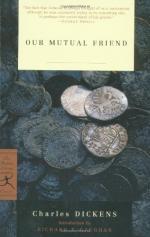|
This section contains 9,841 words (approx. 33 pages at 300 words per page) |

|
SOURCE: “The Motif of Reading in Our Mutual Friend,” in Nineteenth-Century Fiction, Vol. 28, No. 1, June, 1973, pp. 38-61.
In the following essay, Friedman explores the way the motifs of reading and literacy serves not only to reinforce the themes of Our Mutual Friend, but also to help move the plot forward and to define characters.
Two-thirds of the way through Dickens' Our Mutual Friend, Eugene Wrayburn responds to his friend's criticism:
“You charm me, Mortimer, with your reading of my weaknesses. (By-the-bye, that very word, Reading, in its critical use, always charms me. An actress's Reading of a chambermaid, a dancer's Reading of a hornpipe, a singer's Reading of a song, a marine painter's Reading of the sea, the kettle-drum's Reading of an instrumental passage, are phrases ever youthful and delightful.)”1
Eugene's casual digression, a leisurely “by-the-bye” meandering from an extremely serious discussion, reflects his insouciance and languor. But...
|
This section contains 9,841 words (approx. 33 pages at 300 words per page) |

|


